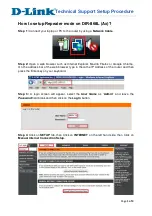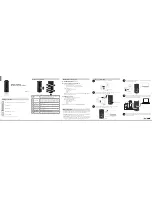
132
Fragment Threshold :
The Fragment Threshold is in the range of
256
~
2346
byte. The default is
2346
byte.
Each Wi-Fi packet can be divided into smaller packets, marked with a sequential fragment number and re-assemble
in the receiving ends. The purpose is to make a short frame, instead of long frame, transmitting by radio in a heavy
noisy environment. Because of sending smaller frames, corruptions are much less likely to occur. The pros is
obvious, the cons is the overhead for transmission. So, in a clean environment, higher fragment threshold can be an
option to increase throughput.
Fragmentation will be triggered by setting the Fragment Threshold, usually in Byte-length. Only when the frame size
is over the Threshold, fragmentation will take place automatically.
RTS Threshold :
TRTS Threshold is in the range of
1~2347
byte. The default is
2347
byte.
The main purpose of enabling RTS by changing RTS threshold is to reduce possible collisions due to hidden wireless
clients. RTS in AP will be enabled automatically if the packet size is larger than the Threshold value. By default, RTS
is disabled in a normal environment supports non-jumbo frames.
Short Preamble :
By default, it’s “
Enable
”. To
Disable
is to use Long 128-bit Preamble Synchronization field.
The preamble is used to signal "here is a train of data coming" to the receiver. The short preamble provides 72-bit
Synchronization field to improve WLAN transmission efficiency with less overhead.
Tx Burst :
By default, it’s “
Enable
”. To
Disable
is to deactivate Tx Burst.
With TX burst enabled, AP will send many packets in a burst, without collision detection and RTS/CTS for each packet. TX
Burst have better throughput but cause interference with other APs in channel.
Pkt_Aggregate :
By default, it's “
Enable
”
Increase efficiency by aggregating multiple packets of application data into a single transmission frame. In this way,
802.11n networks can send multiple data packets with the fixed overhead cost of just a single frame.
IEEE802.11H (DFS) :
By default, it's “
Disable
”. To
Enable
is to use IEEE802.11H(DFS)
With DFS(Dynamic Frequency Selection) enabled, radio is operating on one of the following channels, the wireless
device uses DFS to monitor the operating frequency and switch to another frequency or reduce power as necessary:
DFS Channels
52, 56, 60, 64, 100, 104, 108, 112, 116, 120, 124, 128, 136, 140
The maximum legal transmit power is greater for some 5 GHz channels than for others. When the wireless device
randomly selects a 5 GHz channel on which power is restricted, the wireless device automatically reduces transmit
power to comply with power limits for that channel in that regulatory domain.
The Channel 52-140 is DFS channel. If turns on IEEE802.11H, AP Will have
60
sec to do channel available
check, and will not send beacon and can not be connect. When APO1200/APO1215 detect radar(5GHz) signal,
the AP will switch channel and stop beacon transmit between
15
sec.
WMM :
By default, it's “
Disable
”. To
Enable
is to use WMM and the WMM parameters should appears.
















































